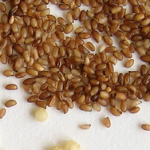Cooking with Non-Gluten Grains
If you have been told that you have to give up gluten grains, you may be feeling a bit lost. This guide to cooking with non-gluten grains can get you started.
Many people who have Celiac disease or gluten intolerance (also called sprue, gluten enteropathy or gluten-sensitive enteropathy) are now stuck with the problem of finding something to eat. This guide will introduce you to the non-gluten grains and link you to some fabulous recipes you can find all over the web.
If you want some help kicking the gluten grains consider trying my 30 Sugar Free Days Program that helps people stop eating sugar and the foods that act like sugar (mostly grains).
Amaranth
 Amaranth is a tall plant that produces millions of tiny seeds. Amaranth seeds are high in protein and they have a distinct nutty flavor. Amaranth mixes well with other grains, try adding a little bit to the next rice dish you make and watch how it enhances the flavor of the meal.
Amaranth is a tall plant that produces millions of tiny seeds. Amaranth seeds are high in protein and they have a distinct nutty flavor. Amaranth mixes well with other grains, try adding a little bit to the next rice dish you make and watch how it enhances the flavor of the meal.
- Cinnamon Amaranth Grits (use Stevia for a non-sugar version)
- Aztec Tapule
- Spanish Style Amaranth
Buckwheat
 Buckwheat has a strong flavor that could be described as nutty or dark. It has a strong flavor that many Western tongues find strange, but give it a try and you will find that its flavor grows on you. Buckwheat is high in manganese, magnesium, zinc and fiber. Buckwheat is a staple of Japanese foods and you can by noodles made out of buckwheat (which many people looking for gluten free foods are looking for).
Buckwheat has a strong flavor that could be described as nutty or dark. It has a strong flavor that many Western tongues find strange, but give it a try and you will find that its flavor grows on you. Buckwheat is high in manganese, magnesium, zinc and fiber. Buckwheat is a staple of Japanese foods and you can by noodles made out of buckwheat (which many people looking for gluten free foods are looking for).
Corn
 Corn is one of those grains that people are familiar with, so when they first switch to a gluten free diet they eat a lot of corn. But corn is a common source of food allergies too, so watch out. That being said, corn is a wonderful and versatile grain that fill the gap when you can’t eat gluten grains. Corn can be eaten right off the cob, but there are also corn noodles and many corn backing mixes. Most people know what to do with corn, so I don’t have a lot of recipes, but here is one I like:
Corn is one of those grains that people are familiar with, so when they first switch to a gluten free diet they eat a lot of corn. But corn is a common source of food allergies too, so watch out. That being said, corn is a wonderful and versatile grain that fill the gap when you can’t eat gluten grains. Corn can be eaten right off the cob, but there are also corn noodles and many corn backing mixes. Most people know what to do with corn, so I don’t have a lot of recipes, but here is one I like:
- Chili Mac (use corn elbow noodles)
Millet
 Millet is one of the tiniest of grains, but it packs a powerful nutritional punch. It has a bit of a nutty taste to it, but not as strong as buckwheat. Anytime you think about using rice, think about substituting with millet. I like to mix millet with other grains (think about a rice/millet pilaf).
Millet is one of the tiniest of grains, but it packs a powerful nutritional punch. It has a bit of a nutty taste to it, but not as strong as buckwheat. Anytime you think about using rice, think about substituting with millet. I like to mix millet with other grains (think about a rice/millet pilaf).
- Broccoli and Cashews over Millet
- Millet Casserole
- Autumn Millet Bake
- Butternut Squash and Millet Cakes
Quinoa
 Quinoa has a distinct flavor but one that most people find enjoyable. Like millet flour, you need to use some binder (see below) to help it stay together when you are baking with it. Quinoa is one of the healthiest of the non-grain grains and you should experiment and use it often.
Quinoa has a distinct flavor but one that most people find enjoyable. Like millet flour, you need to use some binder (see below) to help it stay together when you are baking with it. Quinoa is one of the healthiest of the non-grain grains and you should experiment and use it often.
Rice
 Rice is a staple food all over the world. It is a wonderful addition to any meal. There are rice noodles, but they take a bit of getting used to (sauce doesn’t stick as well to rice as it does to wheat). Once again, most people know what to do with rice, but here are a few recipes.
Rice is a staple food all over the world. It is a wonderful addition to any meal. There are rice noodles, but they take a bit of getting used to (sauce doesn’t stick as well to rice as it does to wheat). Once again, most people know what to do with rice, but here are a few recipes.
Teff
 Teff is the tiniest grain that is used for food. The word Teff means “lost” – supposedly because it is so easy to lose these tiny grains. The taste of Teff can best be described as malty, try mixing a small amount of teff in with your next rice or other grain meal.
Teff is the tiniest grain that is used for food. The word Teff means “lost” – supposedly because it is so easy to lose these tiny grains. The taste of Teff can best be described as malty, try mixing a small amount of teff in with your next rice or other grain meal.
- Teff Polenta with Veggies
- Berbere Stew (lentil and teff stew)
All is Not Lost
You can enjoy your life even if many of the grains you are used to are now gone. Most people who start a non-gluten diet feel much better than they have in years.
If you like baking, take a look at this guide: The Gluten Free Flour Guide.
Do you have some great recipes of your own? Leave them in the comment section below (or provide us with a link to the recipe).













Are there any grains that do NOT result in inflammation?
It’s not clear whether non-glutens don’t result in this unwanted
condition.
Thank you!
Solange,
The answer is probably no. Most grains cause inflammation. Gluten is definitely a suspect in inflammation, but so are lectins. Lectins are proteins that bind to sugars and are found in most grains. Scientists suspect that lectins are part of the protective defenses for plants and they cause us problems when they bind to our digestive tract (causing inflammation).
Hope that helps,
Scott
Hi Dr. Scott! Quick question….if I am baking my own bread from oat flor and other flours, soes the dry heat in baking kill alot of lectins??
Thanks!:)
Suzanne
Suzanne,
Lectins are highest in raw foods (mostly legumes and grains) and they can be destroyed by any processing (grinding, cooking, sprouting, fermenting). Lectins are proteins and are impossible to get rid of completely. I wouldn’t think there would be any difference baking your own or buying bread in the store, unless you fermented and baked the bread.
Hope that helps,
Dr. Scott
i was told by a naturopath that eliminated grains will help control
inflammation
Elaine,
Yes that is true. Your body can react to grains as a foreign invader and your body can increase inflammation as a way to protect itself.